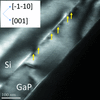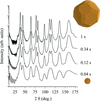issue contents
August 2019 issue

Cover illustration: Usefulness of oils for cleaning the host matrix and for cryoprotection of lipidic cubic phase crystals [Niwa & Takeda (2019). J. Appl. Cryst. 52, 864-868].
research papers
Open  access
access
 access
accessA new temperature-controllable humidifier for X-ray diffraction has been developed. It is shown that the humidifier can successfully maintain protein crystal growth at a temperature lower than room temperature.
This paper reports an Fe-added Y2O3 crucible which is capable of balancing the solution spontaneously and is employed to effectively enhance the homogeneity of YBa2(Cu1−xFex)3O7−δ single crystals.
Ba excess in LaBaGaO4 triggers ionic conductivity together with structural disorder. A direct correlation is found between the density functional theory model energy and the pair distribution function fit residual.
Open  access
access
 access
accessThe unique nucleating and phasing capabilities of the crystallophore, Tb-Xo4, are illustrated through challenging cases.
New fitting analyses of two-dimensional diffraction-spot shapes are demonstrated to evaluate strain, strain distribution and domain size in a crystalline ultra-thin film. The evaluations are displayed as residual and population maps as a function of strain or domain size.
Open  access
access
 access
accessThis work reports a novel methodology to extract quantitative information from small-angle neutron scattering measurements of nanoporous alumina.
An energy resolution of <10 µeV for the measurement of phonon energy change is achieved with the inelastic neutron spin echo technique on a conventional neutron triple-axis spectrometer.
Neutron powder diffraction instrumentation for in situ investigation of solid–gas reactions is described. The setup is demonstrated for an exchange-spring magnet, CoFe2O4/CoFe2.
Because researchers do not understand the formation mechanism of cocrystals, the preparation of cocrystals is mostly done by trial and error. This study focuses on the cocrystal formation mechanism to improve the efficiency of cocrystal preparation.
An X-ray cross-correlation study of the impact of ligand composition and salt content on the self-assembly of soft-shell nanoparticles is presented, indicating symmetry-selective formation of order.
An attempt has been made to combine small-angle scattering of X-rays or neutrons with scanning electron microscopy in reciprocal space, in order to establish a structural analysis method covering a wide range of sizes from micro- to macro-scales.
By using small-angle neutron scattering (SANS) reinforced by scanning electron microscopy, the fine structure of catalysts for polymer electrolyte fuel cells has been investigated. The experimental data resulting from contrast variation with mixed light and heavy water (H2O/D2O) are well described by a core–shell model with fluctuations in concentration between water and Nafion.
This work describes a method to characterize the size distribution of individual aqueous droplets in a high-density and polydisperse aerosol. It is shown that droplets smaller than 120 nm can be generated by purely mechanical means using a gas dynamic virtual nozzle, and theoretical models are provided for the different flow regimes investigated.
The distribution of plastic relaxation defects is studied using a nondestructive sub-micrometre X-ray diffraction scanning technique.
The effects of relative humidity on a tetragonal crystal form of hen egg white lysozyme are studied via in situ laboratory X-ray powder diffraction.
The sin2ψ and cosα methods are compared via diffracting-grain identification from electron backscatter diffraction maps. Artificial textures created by the X-ray diffraction measurements are plotted and X-ray elastic constants of the diffracting-grain sets are computed.
This paper reports on the two-scale fractal structure of chromatin organization in the nucleus of the HeLa cell.
It is shown that artificial neural networks can be used to predict the location and shape of neutron Bragg peaks, resulting in increased integration accuracy.
cryocrystallography papers
Several oils were examined for use in the cleaning and cryoprotection of crystals in the lipidic cubic phase in terms of their effect on the crystal stability, the background scattering and the facilitation of the experiment.
teaching and education
Free 

The Python-based program py_convrot is a universal converter of rigid-body rotation parameters. The program interactively illustrates the action of various rotation parameters and can be used both for teaching goals and for practical applications.
Free 

Python is one of the most popular programming languages for scientific computing. This article shows how to achieve high performance, using specialized libraries and parallel computing, to solve crystallographic problems.
short communications
Single-crystalline-like thin films composed of crystallographically aligned grains are a new prototype of 2D materials developed recently for low-cost and high-performance flexible electronics as well as second-generation high-temperature superconductors. In this work, significant texture improvement in single-crystalline-like materials is achieved through growth of a 330 nm-thick silver layer.
computer programs
BEATRIX, is a new tool for performing data analysis of energy-resolved neutron-imaging experiments involving intense fitting procedures of multi-channel spectra. The use of BEATRIX is illustrated for a test specimen, providing spatially resolved 2D maps for residual strains and Bragg edge heights.
An online knowledge base on the alternate conformations adopted by main-chain and side-chain atoms in protein structures solved by X-ray crystallography is described.
book reviews
Free 

Free 



 journal menu
journal menu














































